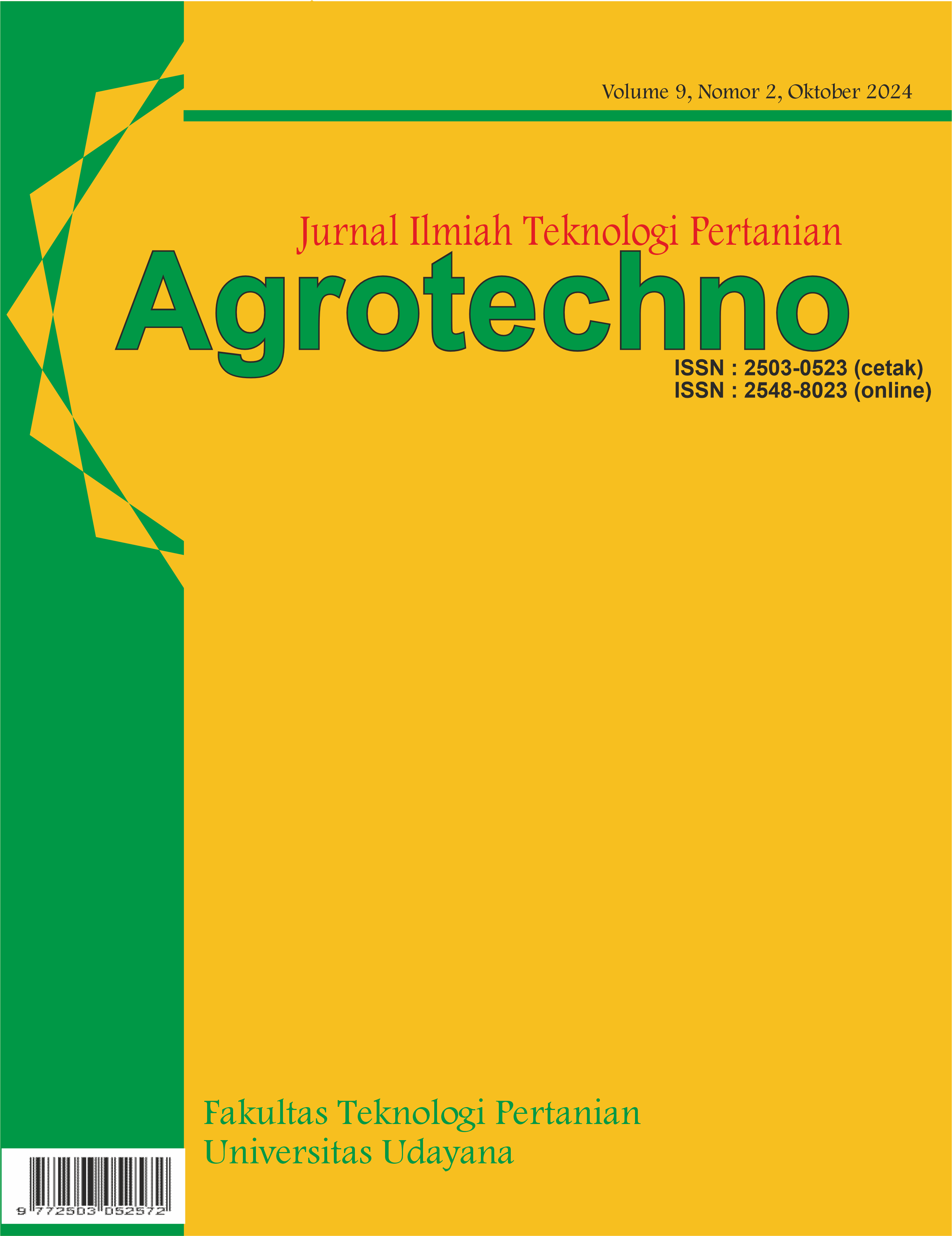Pengaruh Variasi Tingkat Daya dan Waktu Pemanasan Microwave terhadap Karakteristik Tepung Jelai (Coix lacryma-jobi L.)
Abstract
Jelai (Coix lacryma-jobi L.) is a cereal crop belonging to the group of grains (Poaceae). The starch content in jelai plants is very high, around 52%, so it has the potential to be processed into flour. The natural starch found in jelai seeds has the disadvantage that it takes a long time to process and is not resistant to acid treatment. Heating using the microwave method to modified native jelai flour is considered more efficient because it provides faster heating, more homogeneous treatment, and minimizes energy consumption. This study was conducted to determine the effect of power level and microwave heating time on the physicochemical and functional characteristics of jelai flour. This study used a completely randomized design (CRD) with two factors, i.e. power level 20p, 60p. 100p) and heating time (5, 10, 15 minutes) with three replications. This study showed that the variation of microwave power level had a significant effect on bulk density, swelling volume, and solubility, but no significant effect on moisture content and viscosity levels of modified jelai flour. Meanwhile, the variation in microwave heating time has a real effect on solubility, but no significant effect on moisture content, bulk density, swelling volume, and viscosity of modified jelai flour. Microwave power level 20p and heating time of 15 minutes resulted in jelai flour with characteristics closest to wheat flour based on bulk density and solubility value.
Downloads
References
Arygunartha, G. Y., Setianingsih, N. L. P. P., & Sunarso, S. U. P. (2022). Pengaruh proses pengolahan terhadap sifat fisika dan kimia bubuk kedelai: Literature review. Jurnal Impresi Indonesia, 1(2), 89–94. https://doi.org/10.58344/jii.v1i2.21
Dewandari, K. T., Munarso, J., & Rahmawati, R. (2020). Sifat fisikokimia berondong hanjeli (Coix lacryma-jobi L). Jurnal Penelitian Pascapanen Pertanian, 17(3), 154–164.
Dewi, K. L., Ery Aulina, D., Wulandari, F., & Maharani, S. (2022). Modifikasi pati dengan fermentasi (S. cerevisiae) pada tepung pisang, tepung ubi ungu, dan tepung ketan hitam. Edufortech, 7(2), 182–199.
Fadhlillah, M., Ishmayana, S., Idar, I., Soemitro, S., & Subroto, T. (2016). Perubahan sifat fisikokimia tepung sorgum setelah hidrolisis parsial dengan enzim α-amilase dari Bacillus Sp. (termamyl). Chimica et Natura Acta, 4, 21–26.
Fera, T., Ferdiansyah, M. K., Affandi, A. R., & Umiyati, R. (2021). Perbandingan karakteristik bulk density dan serat kasar pada tepung sukun serta tepung terigu. Science And Engineering National Seminar, 6(Sens 6), 4–7.
Fiqtinovri, S. M., Adriansyah, D., & Risnafaty. (2023). Karakteristik struktur, amilograf, dan kecernaan pati alami jelai (Coix lacryma-jobi L). Jurnal Teknologi Hasil Pertanian, 16(1), 29–40.
Fitriani, S., Yusmarini, Riftyan, E., Saputra, E., & Rohmah, M. C. (2023). Karakteristik dan profil pasta pati sagu modifikasi pragelatinisasi pada suhu yang berbeda. Jurnal Teknologi Hasil Pertanian, 16(2), 104. https://doi.org/10.20961/jthp.v16i2.56057
Gaarnida, Y., Hervelly, & Rahma, R. N. (2019). Modifikasi tepung ganyong (Canna edulis Kerr.) Metode heat moisture treatment pada suhu dan waktu pemanasan berbeda dan aplikasi tepung pada pembuatan cookies. Pasundan Food Technology Journal, 6(1), 65. https://doi.org/10.23969/pftj.v6i1.1508
Haryanti, P., Setyawati, R., & Wicaksono, R. (2014). Pengaruh suhu dan lama pemanasan suspensi pati serta konsentrasi butanol terhadap karakteristik fisikokimia pati tinggi amilosa dari tapioka. Agritech, 34(3).
Hervelly, Garnida, Y., & Nastiti, A. G. (2020). Karakteristik flakes yang dihasilkan dari tepung hanjeli (Coix lacryma jobi l.) Termodifikasi dengan metode heat moisture treatment. Pasundan Food Technology Journal, 7(1), 33–37. https://doi.org/10.23969/pftj.v7i1.2693
If’all, I., Hasanuddin, A., Rahim, A., & Kadir, S. (2021). Karakteristik fisik, kimia, dan fungsional pati ubi banggai asetat pada berbagai variasi waktu reaksi. AgriTECH, 40(4), 340. https://doi.org/10.22146/agritech.48983
Jufri, M., Dewi, R., & Firli, A. R. (2006). Studi kemampuan pati biji durian sebagai bahan pengikat dalam tablet ketoprofen secara granulasi basah. Pharmaceutical Sciences and Research, 3(2). https://doi.org/10.7454/psr.v3i2.3401
Michalak, J., Czarnowska-Kujawska, M., Klepacka, J., & Gujska, E. (2020). Effect of microwave heating on the acrylamide formation in foods. Molecules, 25(18), 1–21. https://doi.org/10.3390/molecules25184140
Nuraeni, E. (2019). Optimalisasi Formula Cookies Berbasis Tepung Hanjeli (Coix lacryma-jobi L.) Dengan Menggunakan Design Expert Metoda D-Optimal [Universitas Pasundan]. In Jurnal Kajian Pendidikan Ekonomi dan Ilmu Ekonomi (Vol. 2, Issue 1). http://www.scopus.com/inward/record.url?eid=2-s2.0-84865607390&partnerID=tZOtx3y1%0Ahttp://books.google.com/books?hl=en&lr=&id=2LIMMD9FVXkC&oi=fnd&pg=PR5&dq=Principles+of+Digital+Image+Processing+fundamental+techniques&ots=HjrHeuS_
Nurmala, T. (2011). Potensi dan prospek pengembangan hanjeli (Coix lacryma jobi L) sebagai pangan bergizi kaya lemak untuk mendukung diversifikasi pangan menuju ketahanan pangan mandiri. Jurnal Pangan, 20(1), 41–48.
Rahman, R. F., Edison, & Ilza, M. (2019). Pengaruh pemanasan microwave terhadap kandungan protein tepung ikan tembakul (Periophthalmus minutus). Jurnal Kajian Pendidikan Ekonomi Dan Ilmu Ekonomi, 2(1), 1–19. http://www.scopus.com/inward/record.url?eid=2-s2.0-84865607390&partnerID=tZOtx3y1%0Ahttp://books.google.com/books?hl=en&lr=&id=2LIMMD9FVXkC&oi=fnd&pg=PR5&dq=Principles+of+Digital+Image+Processing+fundamental+techniques&ots=HjrHeuS_
Rodhiyah, Rahmatulloh, A., & Firdaus, R. C. (2024). Perbandingan analisis parameter moisture content flavour powder menggunakan moisture analyzer dan oven. DISTILAT: Jurnal Teknologi Separasi, 10(1), 287–295. https://doi.org/10.33795/distilat.v10i1.4877
Subroto, E., Indiarto, R., Wulandari, E., & Astari, A. P. (2021). Modifikasi pati hanjeli (Coix lacryma-jobi L.) berpori melalui ultrasonikasi dan ozonasi. Jurnal Teknologi Hasil Pertanian, 14(2), 117. https://doi.org/10.20961/jthp.v14i2.54338
Waluyo, Pranoto, Y., Sardjonon, & Marsono, Y. (2021). Peningkatan pati resisten dan karakteristik tepung kacang merah (Phaseolus vulgaris L.) Pratanak metode kombinasi pengukusan, oven microvawe, autoclav dan pendinginan. Jurnal Nutrisia, 23(1), 32–43. https://doi.org/10.29238/jnutri.v23i1.217
Yanli, X., Mingxia, Y., Shasha, Y., Shumin, S., & Quangong, H. (2013). Effect of microwave treatment on the physicochemical properties of potato starch. Chemistry Central, 7, 1–7. https://doi.org/10.1016/j.fbio.2023.102613
Zailani, M. A., Kamilah, H., Husaini, A., & Razid, S. (2021). Physicochemical properties of microwave heated sago (Metroxylon sagu) starch. CYTA - Journal of Food, 19(1), 596–605. https://doi.org/10.1080/19476337.2021.1934550










